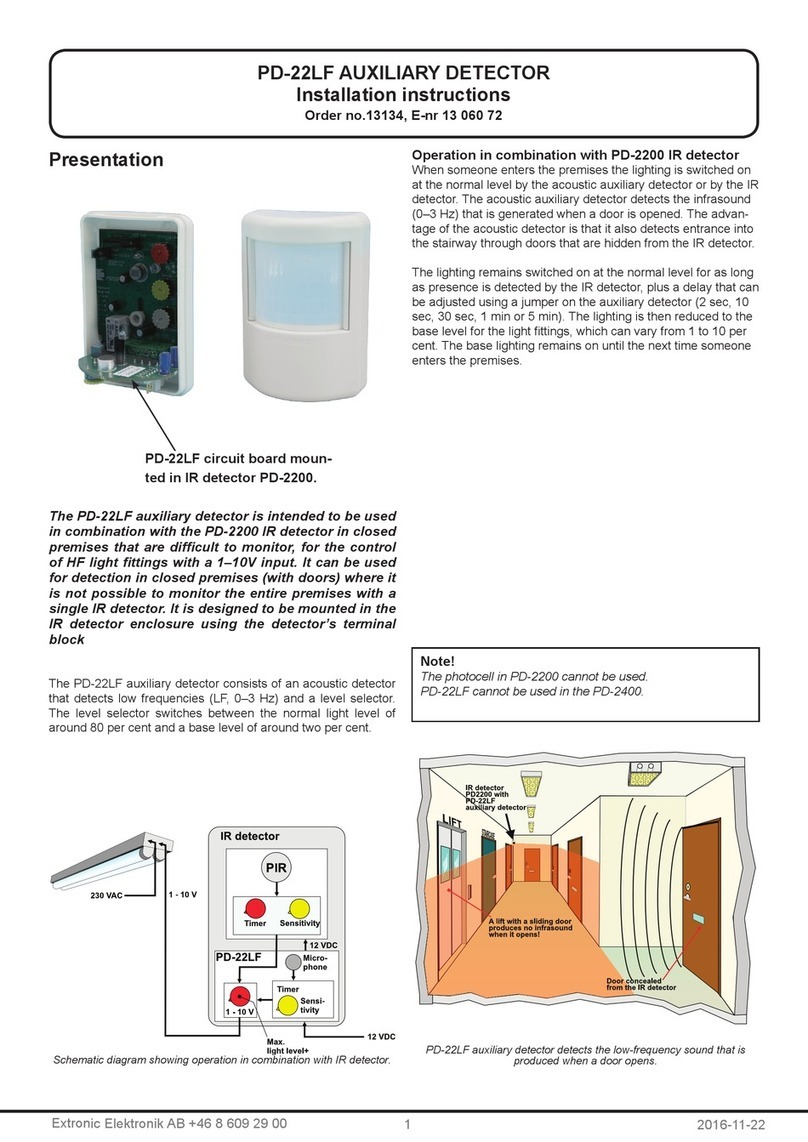
5. Signal analyse
PD-2200/-2400 with microprocessor analysing the signals from
the pyroelectric detector has algorithms that continuous counts
single pulse, sum of pulse and noise level.
Single pulse is a method used for ex. entering into a premises.
A fast method that activate when signal is strong enough.
Sum of pulse a slower method of
measurement that takes longer de-
tecting a human. Used i.e. when low
activity, as for sitting people and sig-
nal does not reach level single pulse.
Level is chosen with potentiometer
“Sensitivity”
PD-2200/-2400 automatically adjust sensitivity after estimated
noise level. A time laps of 1-2 minutes after movements detec-
ted by detector before the detector will increase sensitivity. Chan-
ge of sensitivity with up to 20% from adjusted value.With jumper
“Activity High/Low-Ofce” adjustment of detector is possible ac-
cording to locality.In localities with part time low activity where de-
tection is unclear the detector could let the light be switched on
for a longer period.
6. Commissioning
Checklist
Check the installation using the checklist below. If in doubt, re-
fer to the manual “Energy-efcient detection technology”, order
no. 35100.
Always consider the following questions for each installation:
1. Is the correct detector being used?
2. Is it placed in the correct corner?
3. Is it at the correct height?
4. Is the correct lens tted?
5. Is the correct logic unit being used?
6. Is the power supply correctly rated for the detectors,
relays and logic?
7. Do you have the necessary skills and tools to carry out
nal adjustment of the installation?
You should also answer the following questions about the light
sources:
1. Is the correct type of light source being used?
2. Is the correct control method being used for the
light source?
3. Is the correct type of ballast being used?
If you can answer yes to all the questions in the checklist then
you can continue with commissioning.
• Check the voltage and polarity, and connect the power
supply.
• Set the “Photocell” to “Off”. If the photocell is not to be used
it should always be turned off. See the “Photocell” section if
the photocell is to be used.
• Turn down the delay time to “Min” using the “Time” poten-
tiometer.
• Move the jumper to the “Activity High” position.
• Carry out a run test in the entire area covered by presence
detection.
Note! The lens must be tted and the cover must be in pla-
ce. Adjust vertically and horizontally as required.
• After completing the run test and adjustment, set the time
to the lowest possible. In the case of dynamic lighting con-
trol in a stairwell or corridors, for example, this should be
1–2 minutes. In other applications, such as a classroom or
garage, the time should be set to 6–8 minutes or according
to the light source manufacturer’s recommendations.
• Set the jumper according to the level of activity in the
premises.
• Disconnect the LED when adjustment is complete (see
“Jumpers”), to reduce the risk of tampering.
7. Technical specication
Adjustment:
Vertical: +10º to –20º calibrated scale
Horizontal: Up to 30º.
Electrical:
Voltage: 10 - 16 VDC.
Current: 25 mA vid 13,8 VDC.
Start-up time: < 2 minutes.
Relay output: Changeover contacts
1 A / 30 VDC, 100 VDC/0,3A
0,5 A // V125 VAC (resistive).
LED: Walking test (switchable).
Test point::For background interference..
Detector: Dubbelelements-, lågbrus,
pyroelektrisk IR-detektor.
Enclosure: IP42.
Dimensions: 102 x 70 x 50 mm.
Weight: 98 g.
Extronic Elektronik AB | 08 609 29 00 32016-11-04






















